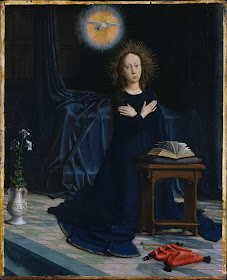 |
| Fra Roberto Caracciolo, prediche vulghare 1491 woodcut, Florence |
"Sermons were a very important part of the painter's circumstances: preacher and picture were both part of the apparatus of a church, and each took notice of the other. The fifteenth century was the last fling of the medieval type of popular preacher. . . . Fra Roberto Caracciolo da Lecce is a convenient example: Cosimo de' Medici thought he dressed too sharply for a priest, and his sense of the dramatic was strong – during a sermon on the Crusade he stripped off his habit to reveal, Erasmus noted with distaste, the crusader's livery and armour underneath – but his sermons as we have them are decorous enough. . . . Fra Roberto preaching on the Annunciation distinguishes three principal mysteries: (1) the Angelic Mission, (2) the Angelic Salutation and (3) the Angelic Colloquy. Each of these is discussed under five main heads. . . . It is the third mystery, the Angelic Colloquy, that throws light on the fifteenth-century feeling for what, on the level of human emotion, happened to [the Virgin] in the crisis the painter had to represent. Fra Roberto analyses the account of St. Luke (I: 26-38) and lays out a series of five successive spiritual and mental conditions or states attributable to Mary –
1. Conturbatio – Disquiet
2. Cogitatio – Reflection
3. Interrogatio – Inquiry
4. Humiliatio – Submission
5. Meritatio – Merit
The last of the five Laudable Conditions, Meritatio, followed after the departure of Gabriel, and belongs with representations of the Virgin on her own, the type now called Annunziata; the other four – successively Disquiet, Reflection, Inquiry and Submission – were divisions within the sublime narrative of Mary's response to the Annunciation that very exactly fit the painted representations . . . "
– Michael Baxandall, from Painting and Experience in Fifteenth Century Italy (1972)
CONTURBATIO – DISQUIET
 |
| Filippo Lippi Annunciation (Disquiet) ca. 1445 oil on panel Martelli Chapel, San Lorenzo, Florence |
 |
| Sandro Botticelli Annunciation (Disquiet) 1489 tempera on panel Galleria degli Uffizi, Florence |
 |
| Parmigianino Annunciation (Disquiet) ca. 1528-29 etching, engraving Philadelphia Museum of Art |
COGITATIO – REFLECTION
 |
| Fra Carnevale Annunciation (Reflection) ca. 1445-50 tempera on panel National Gallery of Art, Washington DC |
 |
| Joos van Cleve Annunciation (Reflection) ca. 1525 oil on panel Metropolitan Museum of Art, New York |
 |
| Correggio Annunciation (Reflection) ca. 1522-25 drawing Metropolitan Museum of Art, New York |
INTERROGATIO – INQUIRY
 |
| Alesso Baldovinetti Annunciation (Inquiry) 1447 tempera on panel Galleria degli Uffizi, Florence |
 |
| Filippo Lippi Annunciation (Inquiry) 1437-39 tempera on panel Frick Collection, New York |
 |
| Vittore Carpaccio Annunciation (Inquiry) 1504 oil and tempera on canvas Ca' d'Oro, Venice |
HUMILIATIO – SUBMISSION
 |
| Fra Angelico Annunciation (Submission) ca. 1437-46 fresco Museo Nazionale di San Marco, Florence |
 |
| Gerard David Annunciation (Submission) 1506 oil on panel (half of diptych, Angel Gabriel on facing panel) Metropolitan Museum of Art, New York |
MERITATIO – MERIT
 |
| Antonello da Messina Virgin Annunciate (Merit) ca. 1473 oil on panel Alte Pinakothek, Munich |
 |
| Fra Angelico Virgin Annunciate (Merit) ca. 1450-55 tempera on panel Detroit Institute of Arts |
Facial expression is a bad guide to the emotional lives of these long-ago painted people. Traditions of gesture, posture, and costume carried far more of the burden that we (conditioned by the cinematic close-up) now expect the face to bear.